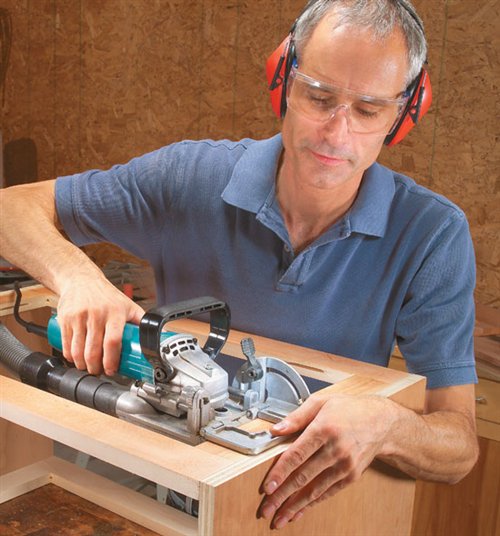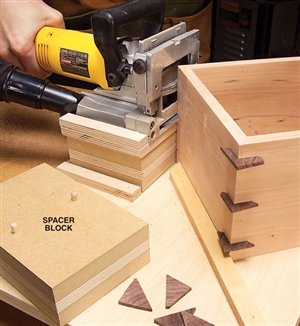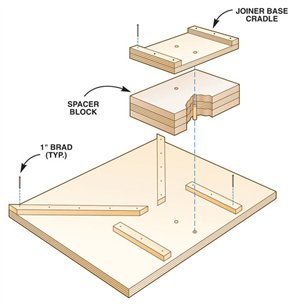We may receive a commission when you use our affiliate links. However, this does not impact our recommendations.
12 Tips for Better Biscuit Joining
Improve performance and expand function.
By Richard Tendick
1. Make Corner Splines
 Decorative corner splines sure make an ordinary box look great. But they can be a bit dicey to cut on a tablesaw. Let your plate joiner come to the rescue. A simple jig holds the box and the joiner so you can cut slots quickly with minimal setup hassles. The jig is nothing more than a piece of scrap plywood with two wood strips set at 90 degrees to each other. A cradle fits around the plate joiner base and keeps it from rocking on the box corner. The cradle is indexed to the jig with a couple dowels. Use spacer blocks to adjust the spline spacing. Plunge the joiner into the wood slowly to prevent tear-out where the blade exits the wood. With this box, you only need one spacer block; just flip the box over to cut the upper slot.
Decorative corner splines sure make an ordinary box look great. But they can be a bit dicey to cut on a tablesaw. Let your plate joiner come to the rescue. A simple jig holds the box and the joiner so you can cut slots quickly with minimal setup hassles. The jig is nothing more than a piece of scrap plywood with two wood strips set at 90 degrees to each other. A cradle fits around the plate joiner base and keeps it from rocking on the box corner. The cradle is indexed to the jig with a couple dowels. Use spacer blocks to adjust the spline spacing. Plunge the joiner into the wood slowly to prevent tear-out where the blade exits the wood. With this box, you only need one spacer block; just flip the box over to cut the upper slot.
2. Preserve our Biscuits with Kitty Litter
Nothing is more aggravating than a biscuit that won’t fit into a slot—except maybe a whole bag of biscuits that won’t fit. Biscuits swell as they absorb moisture, whether from glue or the air. To prevent swollen biscuits, store them with a desiccant, such as kitty litter. The kitty litter absorbs moisture and keeps the air inside the container dry. Pour a small amount of kitty litter (the crystalline variety is less messy) onto a cloth, tie it up and toss it into the container. No more fat biscuits and they’ll always smell nice.
3. Highlight Cast-in Marks on Your Joiner
The cast-in alignment marks on a joiner can be difficult to read. If you’re tired of squinting, use a permanent marker to highlight the marks. The difference it makes will amaze you.
4. Apply Glue with an Acid Brush
Glue must be evenly applied throughout the biscuit slot to get the strongest joint possible. The easiest way? Squirt some glue into the slot and then run a glue brush, sometimes called an acid brush, through the slot until the glue is evenly coated on both sides and the bottom.
5. Use Gauge Blocks for Double Biscuit Joints
Gauge blocks are handy for cutting double biscuit joints. Cut the first slot with the joiner base referenced off the work surface. Then, use a spacer block under the joiner base for the second cut. The gauge block eliminates the hassle and confusion of flipping your stock or resetting the fence. Make a whole set and you’ll be covered for any biscuit-spacing need.
6. Run Biscuits Long in Narrow Frames
You don’t have to own a mini-biscuit joiner to assemble narrow frames. If possible, simply shift the slots so the larger biscuit extends into areas where it won’t be seen, for example, the top or bottom of a face frame. After the glue has dried, cut the protruding biscuit with a handsaw. Then flush-trim with a router or sander.
7. Hold the Fence for Accuracy
It’s easy to misalign a slot with both your hands on the joiner’s handles. Working that way, you can’t feel whether the fence is fully in contact with the stock. The slightest shift up or down on the handle can cause the biscuit slot to be cut wrong. Use one hand to hold the fence down onto the board and you’ll eliminate errors.
8. Quick, Accurate Fence Settings
Gauge blocks work great for quick, accurate fence settings. All you do is pinch the block between the fence blades. This technique will also ensure the fence is set parallel to the blade. Joiners with rack-and-pinion fence adjustments automatically set the fence parallel with the blade. For this type of joiner, use spacer blocks between the fence and a flat surface—like your benchtop—for rapid fence settings.
9. Take a Quick Test for the Right Fit
Don’t use a biscuit that fits loosely in the slot. All you’ll get is a weak joint. Dry-fit biscuits in their slots before glue-up. The biscuit should slide into the slot with hand pressure. Then, hold the board so the biscuits are hanging. A biscuit that is too loose will fall out. Don’t forget to test the other side of the joint in the same way.
If you have a slot that’s too big for any biscuit, glue a shim into the slot and then recut the slot.
10. Alternate Grain Direction when Using Double Biscuits
Biscuits are made from compressed beech wood. The grain runs diagonally across the biscuit. The biscuit is weakest along this grain line. When you install two biscuits in a joint, put them in with the grains running in opposite directions. This will counteract the short-grain weakness in each biscuit.
11. Cut a Double-wide Slot for Added Strength
Using two biscuits in a double-wide slot is a great way to increase joint strength when the stock is too thin for two separate slots. This is especially useful when joining a 3/4-in.-thick table apron to a leg. Some manufacturers include or offer a 4-mm spacer that fits under the fence for this task, but you can easily make one yourself from scrap wood. Create the double-wide slot by inserting the spacer after the first cut. This will raise the blade just the right amount to create room for a second biscuit.
Test the slot depth
Biscuit slots that are too shallow won’t allow the boards to go together. Cut the slots too deep and most of the biscuit is buried in one side, weakening the joint. Here’s a quick test to see whether your joiner is set right. Cut a test slot, slip in a biscuit and draw a pencil line. Take the biscuit out, turn it around and reinsert it. A second pencil line should be 1/16 in. beyond the first line. This will provide a 1/32-in. clearance around the biscuit for excess glue. Refer to your owner’s manual to adjust the depth of cut at a given setting.
Source
Highland Hardware, highlandhardware.com, 800-241-6748, Glue brushes, #166025; #107792.
This story originally appeared in American Woodworker May 2006, issue #121.
Finally, this rare issue of American Woodworker (Digital Issue) magazine can be yours! Discover the fascinating contents of the May 2006 issue including such plans, projects, and articles as:
- Tool Test: Biscuit Joiners: Two of the Best Cost just $100
- Dream Bookcase You can Build in a Small Shop
- Square up Rough Lumber: Get it Pefect and the Rest is Easy
- More Kitchen Storage: Build Roll-Outs the Easy Way
- 12 Tips for Better Biscuit Joints
- The Best Glue for Laminating Wood
Here are some supplies and tools we find essential in our everyday work around the shop. We may receive a commission from sales referred by our links; however, we have carefully selected these products for their usefulness and quality.






















